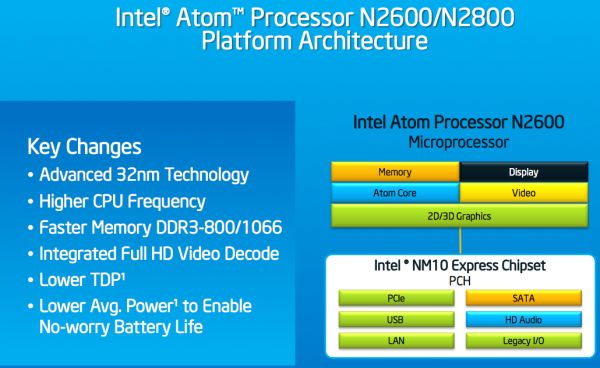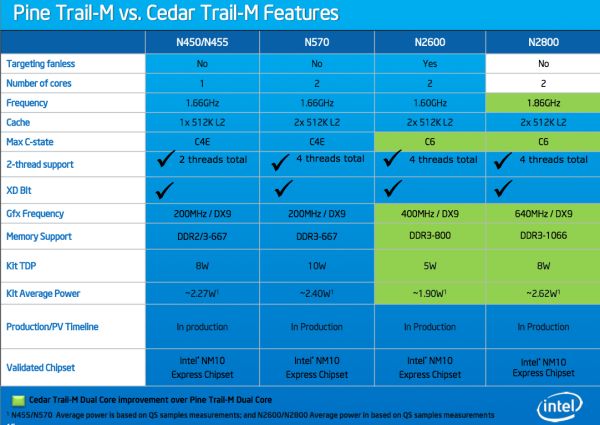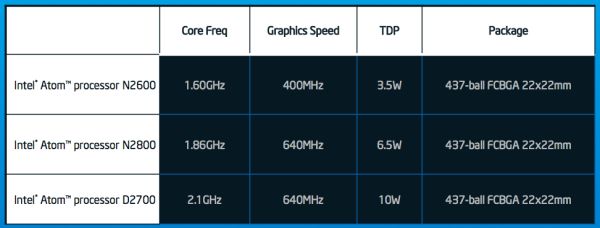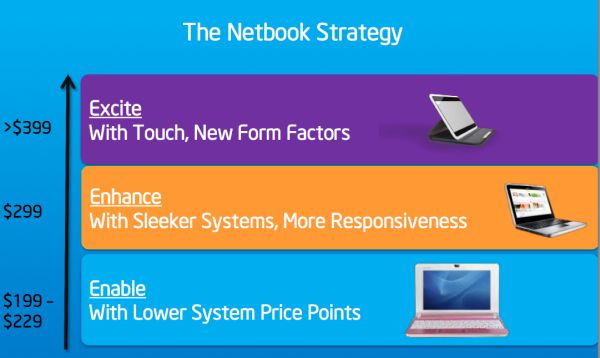Intel's Atom N2600, N2800 & D2700: Cedar Trail, The Heart of the 2012 Netbook
by Anand Lal Shimpi on December 28, 2011 11:00 AM EST- Posted in
- CPUs
- Intel
- Atom
- Cedar Trail
Netbooks aren't dead, but they're not quite the hip topic of discussion they were a few years ago. The focus on cost conscious computing hasn't changed since the introduction of the first netbook, but the maturity of tablets has. Intel still sees the netbook segment as a profitable one (for itself) through 2012, although I'm fully expecting the line between netbook and convertible tablet to blur after the launch of Windows 8.
Atom has been at the heart of nearly all netbooks since the segment's inception. We've seen only one major platform shift since then: from the original 2008 Atom platform to Pine Trail. Pine Trail integrated the GPU and memory controller without significantly changing the Atom architecture. Today Intel is officially announcing its next major netbook platform shift: Cedar Trail.
While the original Atom and Pineview (Pine Trail's Atom) were built on Intel's 45nm process, Cedar Trail moves to 32nm. Cedar Trail's SoC shrinks to 56mm2, finally making it smaller than AMD's Zacate APU. The underlying CPU architecture hasn't really changed, nor have cache sizes (512KB L2 per core) or clock speeds (1.66GHz and 1.86GHz parts available), so what this is really about is a reduction in power consumption.
There are three Atom CPUs being offered as a part of Cedar Trail: the N2600, N2800 and D2700. Just as before, the N-series are for netbooks while the D-series are for desktops. All of the Cedar Trail Atoms are dual-core parts, but they all slot into the same power envelope as the old single-core Pine Trial platforms (5 - 8W). The only exception is the D2700 which is a 10W platform. Note that this is the total TDP for the Atom SoC + the NM10 Express chipset (providing USB, LAN, PCIe, etc...).
The spec breakdown is below:
Given the same number of cores and the same clock speeds, CPU performance shouldn't go up compared to Pine Trail. Since everything is now dual-core we should see a boost at the low end, but I wouldn't expect to see CPU performance that's better than Zacate.
Cedar Trail now supports DDR3-800 and 1066 (up from 667MHz max data rates before). The bigger change is the GPU. The GMA 3150 used in Pine Trail was an Intel Gen graphics derivative (45nm GMA 3100), however Cedar Trail now features a PowerVR SGX 545 sourced from Imagination Technologies. At 640MHz in the N2800, we've never seen the SGX 545 run at anywhere near this clock speed before so it'll be interesting to see how well it performs. Intel is claiming a > 2x GPU performance improvement compared to the GMA 3150 in Pine Trail in 3DMark 06. The big question is Windows driver maturity, but we'll find out soon enough as systems based on Cedar Trail are in production now and are expected to ship in early 2012. Expect to see Cedar Trail netbooks from ASUS, Acer, HP, Lenovo, Samsung and Toshiba for starters.
The new graphics block also includes support for H.264 video decode acceleration (we're still digging for specifics) as well as Intel Wireless Display technology. Note that WiDi support will vary depending on the system and price point:
Intel is expecting the vast majority of Cedar Trail netbooks to be sold in the $199 - $229 price point. At $299 is where you'll likely find features like WiDi as well as potentially fanless designs. Don't expect any of those new form factors at $399 until the later part of next year, likely coinciding with Windows 8's release.
Overall the addition of HD video decode support and lower power consumption are both nice features to have, but I'm skeptical as to whether this will be enough to carry Intel based netbooks throughout the majority of 2012. Atom is in dire need of an architecture update (something we'll get in 2013) and the netbook as a platform is in need of a refresh. I do hope to see some manufacturers taking risks with slim, fanless Cedar Trail based designs next year but we'll have to wait and see if they're any good.














38 Comments
View All Comments
matheusber - Wednesday, December 28, 2011 - link
well, I was hoping there would be gain in performance, but as all is the same, a netbook may last 1 month in battery, if all runs slow it won't matter. I have an Acer running second gen Atom and Vista, and it has no hurry whatsoever to do anything.Thanks AMD for E-Series.
matheus
MrSpadge - Wednesday, December 28, 2011 - link
E350 or E450 with an SSD, that's the way to go. Add a Thinkpad keyboard and a good screen while we're at it ;)yankeeDDL - Thursday, December 29, 2011 - link
I agree.Brazos is a big winner for mobile.
Of course, since Intel is sponsoring much of teh ultrabook development, they'll have a huge spot anyway.
Still, I look forward to a comparison between cedar trail and brazos.
Since "Krishna" and "Wichita" seem to have been canceled (http://en.wikipedia.org/wiki/AMD_Fusion), to be replaced by a version with an "enhanced bulldozer" core, I wonder how will the competition be in 2012.
I have an E350 (on an HP DM1Z) and could not be happier. Well, no, I could: power is never enough, but it is lightyears from the older Atoms.
It would be nice an in depth comparison between Cedar Trail and Brazos, as well as some updated info on AMD's plans for 2012...
fteoath64 - Sunday, January 1, 2012 - link
Agreed. I also cannot believe WHY Intel would release this junk at this time. They have nothing else better to do?. In the time where most OEMs are giving up on netbooks and going towards tablets, this chip is about 4 years late yet under performing in graphics. A real shame.nukunukoo - Wednesday, December 28, 2011 - link
Same Atom, performance is just masked by the GPU. Meh. Let the "fast enough" crowd troll in...therealnickdanger - Wednesday, December 28, 2011 - link
I guess it all depends upon how diverse the "integrated full HD video decode" and "HD audio" actually is. Dual-core (4 threads) plus truly FULL video decode beyond just H.264 should be plenty fast for many people. If the the video decode also properly transmits 1080p at 23.976Hz instead of 24.000Hz (unlike Sandy Bridge) along with HD audio codecs, then this could be a VERY popular low-power HTPC platform. But we'll have to wait for more details.maroon1 - Thursday, December 29, 2011 - link
D2700 has clock speed of 2.13GHz (which is higher than any older D series)N2800 has clock speed of 1.83GHz (which is higher than any older Dual Core N series)
So, saying that there is no CPU speed improvement is very misleading. It might have similar IPC, but clock speed went up and TDP went down
ALso, people here are comparing those to E-350. This ridiculous. Netbook that use this processor cost over $360
While the ones that going to use N2600 and N2800 are going cost below $240. Not sure why people comparing two products with two different price range and TDP.
I mean it more fair to compare those newer atoms to C-50 or C-60 which is closer in price and TDP. Cheapest C-60 netbook on newegg cost $310 (which is still more expensive)
mmaestro - Wednesday, December 28, 2011 - link
If the N2600 can be made fanless, why not? I have an Oak Trail based tablet I'm using right now, and the damn thing's useless. For basic, basic tasks I don't think it needs a lot more punch, but 4GB of DDR3 and dual cores would make a huge difference in what is an extraordinarily frustrating experience right now. With any luck, we'll see some tablets coming soon at CES.dmk2000 - Wednesday, December 28, 2011 - link
Well. That is a reason I got MSI Windpad 110w with AMD APU. Upgraded Toshiba slow SSD with Adata 60 Gb one and now this thing is a blast. With HDMA I connected this thing to 46" LCD and it is a great player 1080p.No Atom can touch it (did I say it last about 4 hours on battery).
So this new refreshed ATOMs are waist of time.
LtGoonRush - Wednesday, December 28, 2011 - link
It would be nice to see Intel fix their long-standing architectural error of separating out the memory controller and processor cores. (For those unaware, they're on the same piece of silicon but are still on separate devices with a very short FSB connecting them). This approach seems like it would save power and die area compared to Intel's current Clarkdale-esque method, but who knows. The big deal is improving memory latency and throughput, which can help a LOT on devices with integrated graphics. Overall it seems like Intel just isn't trying very hard, something they can only get away with because AMD has had trouble scaling production of their Brazos APUs.